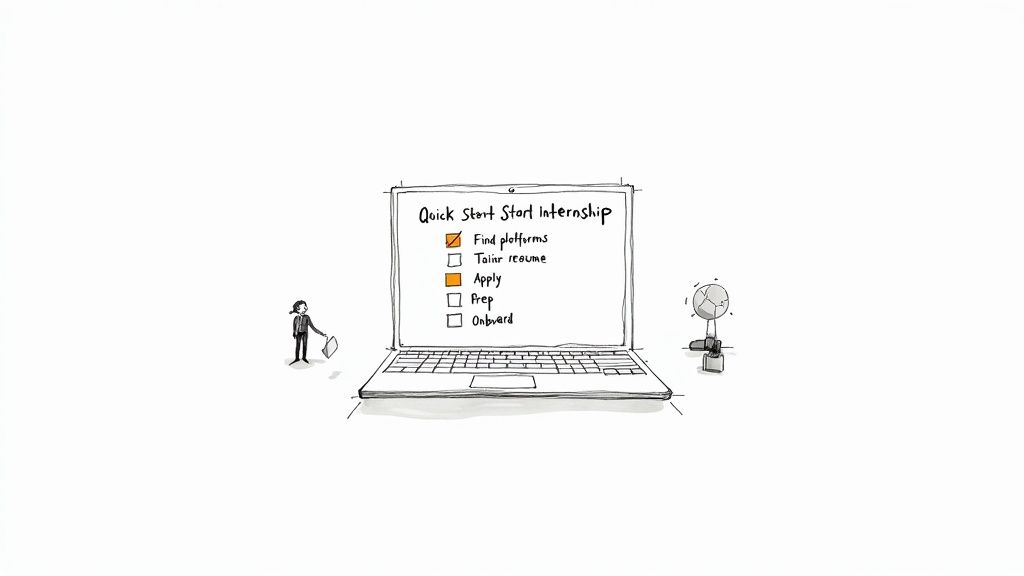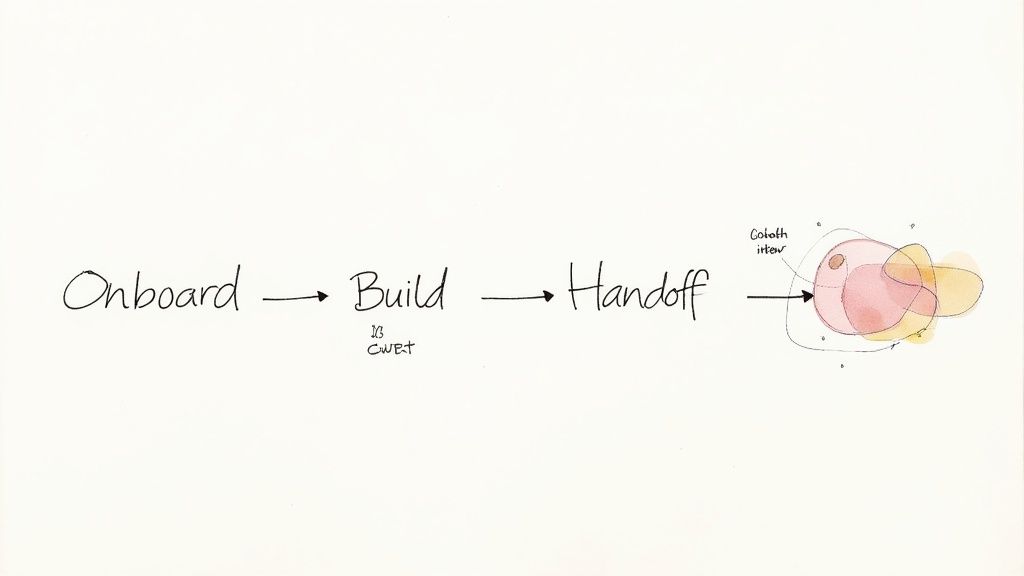TL;DR
- For Interns: Build a strong GitHub portfolio with well-documented projects. Focus on demonstrating your ability to communicate asynchronously and work autonomously during interviews.
- For Hiring Managers: Structure a 10–12 week program with a tightly-scoped project, a dedicated mentor, and a clear onboarding checklist. Measure intern performance on deliverables, not hours.
- Best Opportunities: Skip generic job boards. Focus on niche remote sites like We Work Remotely, open-source contributions, and developer communities like Dev.to.
- Actionable Tip: Interns should practice answering remote-specific interview questions about handling blockers and giving written feedback. Managers should use our onboarding checklist below.
Who this is for
- CTOs and Engineering Managers: You need to build a talent pipeline but want to ensure a remote internship program delivers real business value and identifies future full-time hires.
- Aspiring Software Engineering Interns: You are a student or recent graduate seeking hands-on experience at a top company without the need to relocate.
The 3-Step Framework for a Successful Remote Internship
A successful remote software engineering internship depends on a structured partnership. The intern must demonstrate initiative and communication, while the company must provide clear goals and support. The process breaks down into three stages: Find, Apply, and Succeed.
This framework requires deliberate action from both sides.
Why Remote Internships Are a Strategic Advantage
Remote software engineering internships are no longer a pandemic-era compromise; they are a core strategy for building high-performing engineering teams. Companies gain access to a global talent pool, increasing team diversity and reducing time-to-hire. For interns, it removes geographical and financial barriers to entry, democratizing access to top-tier roles.
This isn't a niche trend. According to a 2025 Stack Overflow survey, 45% of U.S. software engineers work remotely. This shift is mirrored in internships, with platforms like WayUp and Indeed reporting a 40% increase in remote software engineering internship listings between 2022 and 2025.

For interns, the benefits extend beyond flexibility. A remote internship forces you to develop critical skills for the modern workplace:
- Asynchronous Communication: Mastering clear, concise written updates in tools like Slack and GitHub.
- Autonomy: Learning to manage your own time and drive projects forward without direct supervision.
- Documentation: Creating clear READMEs and project notes so others can understand and build upon your work.
Excelling in a remote internship demonstrates you can thrive in a modern, distributed team—a powerful signal to future employers. As The Pragmatic Engineer often highlights, understanding the market is key, and the market clearly shows whether software engineers are in demand depends on these modern skills.
Practical Example 1: Crafting a Remote-Ready Application
Hiring managers for remote roles fear one thing: an intern who requires constant hand-holding. Your application must prove you are an independent, reliable contributor.
Bad Resume Bullet Point:
- Worked on a team project to build a web app.
Good Resume Bullet Point (Remote-Optimized):
- Collaborated with a distributed 4-person team to build a React-based scheduling app, managing tasks via Jira and conducting asynchronous code reviews on GitHub to meet a 6-week deadline.
Your portfolio is where you provide the evidence. A strong GitHub profile with clean, documented code and detailed READMEs is non-negotiable. Explore these software engineer portfolio examples for inspiration.
To find the best roles, focus on niche job boards like We Work Remotely, RemoteOK, and Otta. Engage with communities on Dev.to and Stack Overflow. Many global opportunities are also aggregated on GitHub repositories like this one.
Practical Example 2: The Remote Technical Interview Question
Remote interviews test communication and problem-solving under pressure, not just coding. You will be evaluated on how you articulate your thought process.
Typical Interview Question:
"Imagine you disagree with a senior engineer’s suggestion on a pull request. How would you phrase your feedback in a written comment?"
A Strong Answer:
"First, I'd thank them for the feedback. Then, I'd acknowledge the benefit of their approach, such as 'I see how this method would improve performance in X scenario.' Next, I'd concisely state my alternative and its trade-offs, like, 'I initially chose this other approach because it's more readable for new developers and handles Y edge case. What are your thoughts on the trade-off between performance and readability here?' I’d end with an open question to encourage collaboration rather than confrontation."
This answer demonstrates respect, clear technical reasoning, and a collaborative mindset—all critical for asynchronous teamwork. Prepare for interviews by testing your tech setup (webcam, mic, collaborative tools like CoderPad or HackerRank) and verbalizing your thought process as you solve problems. Knowing the core skills required for a software engineer will help you frame your answers.

Deep Dive: How to Structure a High-Impact Remote Internship Program
A successful remote internship doesn't happen by accident. It requires a deliberate structure that prevents intern disengagement and ensures their work provides real value. The foundation is a "Goldilocks" project: not too big, not too small, and self-contained enough to be completed in a 10–12 week timeframe.
Good Intern Project: Build an internal Command Line Interface (CLI) tool to automate new developer environment setup.
Bad Intern Project: Fix a random queue of low-priority bugs from the backlog.
The first project has a clear goal, delivers tangible value, and allows the intern to own something from start to finish. The second leads to a disjointed, unfulfilling experience.
Example Architecture for an Intern Project: CLI Tool
A project to build an internal CLI tool is ideal for a remote intern. It touches multiple parts of the stack without risking production systems and has a clear definition of "done."
This architecture is contained, testable, and allows the intern to work autonomously while interacting with key APIs and services. The business impact is immediate: reduced onboarding time for all new engineers.
Your First-Week Remote Onboarding Checklist
A structured first week is critical for setting a remote intern up for success. Use this checklist to ensure they are integrated quickly and can start contributing.
Day 1: Welcome & Setup
- Attend company-wide welcome call.
- Complete HR and payroll paperwork.
- Set up dev machine with required software, credentials, and VPN access.
- Receive invitations to key Slack channels, Jira boards, and GitHub repos.
Day 2: Meet the Team & Tech Stack
- 1:1 with mentor to review the scoped project and 90-day goals.
- Schedule 30-min intro calls with 3–4 key team members.
- Clone the primary repository and successfully run the project locally.
- Complete a "hello world" starter task to verify the build process.
Day 3: Your First Contribution
- Pick up a small, well-defined first ticket (e.g., fix a typo, add a log statement).
- Submit your first pull request.
- Participate in your first team stand-up.
Days 4-5: Project Deep Dive
- Review project architecture diagrams and documentation with your mentor.
- Break down the main project into weekly milestones.
- Present your high-level project plan to the team for feedback.
Implementing effective strategies to improve team communication from day one is essential.
Navigating Compensation and Remote Logistics

Clarity on compensation, equipment, and logistics is essential. In 2025, top tech firms offered remote software engineering interns an average of $52/hour, with specialized AI/ML roles reaching up to $70/hour. For more data, discover more insights on the current state of internship compensation.
Equipment Policy Trade-offs:
- Company-Provided Laptop: More secure and ensures a consistent development environment. Involves shipping logistics and upfront hardware costs.
- BYOD with Stipend ($500–$1,000): More flexible and avoids shipping. Requires strict Mobile Device Management (MDM) policies to mitigate security risks.
For time zones, establish a 2–4 hour daily overlap window for synchronous collaboration (stand-ups, pairing) and default to asynchronous communication for everything else. This respects flexible schedules while preventing blockers.
What to do next
- For Hiring Managers: Use the onboarding checklist above to structure your next remote internship. Define a scoped project before you write the job description.
- For Interns: Update your GitHub profile with a detailed README for your best project. Practice answering the remote-specific interview question in this guide.
- Explore Talent: If you're looking to hire top-tier, pre-vetted remote engineers, consider a faster alternative. ThirstySprout can match you with the right talent in days.
Ready to build your high-impact remote engineering team? ThirstySprout connects you with top-tier, pre-vetted AI and software engineers who can integrate with your team and deliver value from day one. Start a Pilot and hire the talent you need in days, not months.
Hire from the Top 1% Talent Network
Ready to accelerate your hiring or scale your company with our top-tier technical talent? Let's chat.

